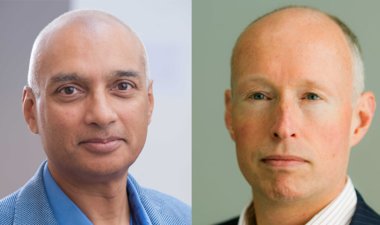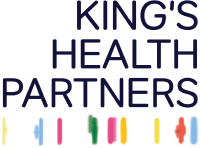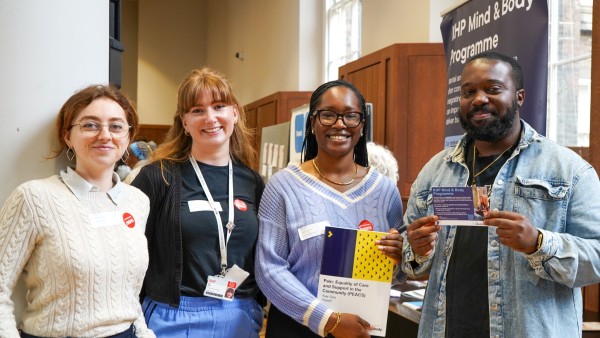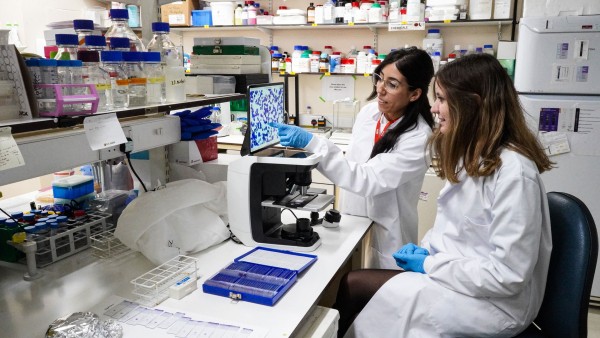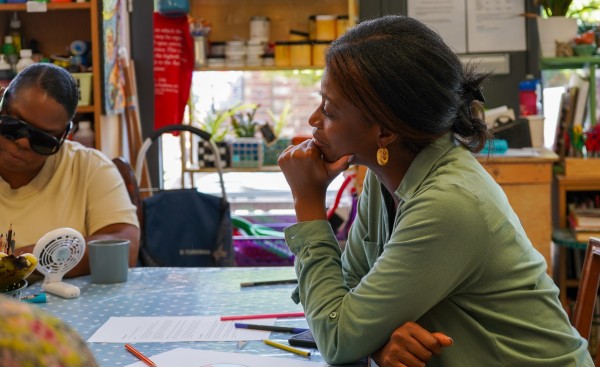3 June 2021
King’s Health Partners Neurosciences leads share how their teams are improving outcomes for patients with epilepsy.
King’s Health Partners epilepsy services are nationally and internationally renowned. Collectively we offer the widest range of treatment options of any epilepsy centre in the UK, including world-class neurosurgery services for those whose seizures do not respond well to medication. We support people with early onset syndromes right the way through to providing expert care for those who have the most complex needs.
As an Institute, we excel at translating cutting edge research into new models of diagnosis and treatment. During this year’s National Epilepsy Week, 24th – 30th May, we spoke with two of our leading clinical academics, Prof Deb Pal [pictured right, left hand side], Professor of Paediatric Epilepsy, King’s College London and Prof Mark Richardson [pictured right, right hand side], Vice Dean (Neuroscience), King’s College London and Joint Director of King’s Health Partners Neurosciences, to hear more about the advances we are making in epilepsy research and how it will enable us to transform care for people with epilepsy over the next few years.
What is your role within King’s Health Partners Neurosciences?
Prof Pal: My name is Deb Pal and I’m Professor of Paediatric Epilepsy at King’s College London. My team’s research focuses on finding the genetic causes of epilepsy. By sequencing patients’ genomes, we are able to identify genetic causes for one in four patients. Knowing the cause means that we can avoid harmful or useless treatments, sometimes offer trials of other repurposed treatments and enter patients into experimental medicine studies. It is also very helpful for patients and their families for genetic counselling. In the next few years, several revolutionary gene-based therapies will become available for precision medicine.
Prof Richardson: I am Head of the School of Neurosciences, King’s College London and Joint Director of King’s Health Partners Neurosciences. I lead a research team that focuses on understanding how and why seizures start. I am also a member of the clinical team providing comprehensive adult epilepsy services to a large population in London and the south east of England. My university role is to lead and oversee the delivery of research and education across the entire spectrum of neuroscience. In my King’s Health Partners Neurosciences role, I am focussed on co-delivering a unified clinical, research, education and training strategy across the partner organisations.
Please tell us about the Institute?
Prof Pal: At the Institute, our approach is to find ways to place patients into different groups so that they might be able to benefit from different management strategies. For example, we are trialling sleep behaviour therapy for children whose seizures are triggered by poor sleep. We are investigating how cognitive and behavioural patterns can give us clues to susceptibility, for example impulsivity seems to predict side effects to a common antiseizure medication. Another example is a national trial at King’s College London that we are leading which is exploring how a special type of epilepsy responds to nicotine patches and whether this might be a treatment option in the future.
Prof Richardson: In the epilepsy service, we are fully integrated across several medical and surgical specialties, including neurology, neurosurgery and neuropsychiatry, as well as the diagnostic specialties of neuroradiology and clinical neurophysiology. Our epilepsy services, in conjunction with the paediatric epilepsy services, provide care across the entire lifespan. Research has been deeply integrated into our clinical practice for decades, since we were one of the very first epilepsy research centres in the world, developing new approaches to epilepsy treatment for half a century. We have also been leaders in education and clinical training in epilepsy.
How is your team seeking to improve outcomes for people with epilepsy?
Prof Pal: First, we have been working with young people and parents to ask what outcomes are important to them and how these should be measured. As a result of this work, we have developed the first outcome measure set for childhood epilepsy. Second, it is clear that approximately one third of patients do not respond to antiseizure medications and we are finding alternative mechanisms to explain treatment resistance, for example seizures as a response to stress in females. And third, by finding genetic explanations we are opening the doors to gene-based therapies. We started England’s first epilepsy genetic clinic in 2016 with the first ever epilepsy genetic counsellor and we have genetically tested 600 patients so far.
Prof Richardson: One of the most debilitating issues for people with epilepsy is that it is very hard to predict when a seizure will happen. People tell us that what affects them most about their condition is the fear of not knowing when a seizure might start or what could trigger a seizure. We are developing novel technology to capture data about when seizures occur and what was the context. By analysing and interpreting these data, we can then understand more about why a person might have a seizure at a specific moment. My team also build simple ‘model brains’ in a computer, using information from brain scans collected in people with and without epilepsy. We use these models to explore how the patterns of connections in the brain can allow seizures to start. One of our current projects, which is part of the international My Seizure Gauge Programme, is focused on developing a way to forecast seizure onset by monitoring the electrical activity of the brain. This is done using a very small device concealed beneath the skin on the head.
This device means we can continuously record electrical activity of the brain over many months. When used alongside wearable sensors that track heart rate and movement data this allows us to better understand conditions before, during and after seizures. Analysing the data lets us make better predictions about how factors such as stress, poor sleep and naturally occurring cycles in the body affect the likelihood of a seizure.
What do you think has had the most positive impact on patients this past year?
Prof Pal: We work very closely with clinicians in the south east of England who belong to the clinical epilepsy network, educating them in genetic literacy. We have reached a point where everyone now understands the value of, and indications for, genetic testing. There is now an open dialogue so that nurses and doctors can ask for opinions and we can make recommendations. We have witnessed massive appreciation of the service from patients, with 100% friends and family satisfaction – some families have been waiting 20 years for an answer.
Prof Richardson: Although our seizure forecasting study is not yet complete, we are already able to show that seizures occur in patterns that may be predictable. A simple approach to using the pattern of occurrence of seizures over time to forecast periods of high risk for seizures is already finding its way into an electronic diary appointment used by many people with epilepsy. I am excited by the potential to empower people with epilepsy to manage their lives through the insights provided by seizure forecasting methods.
What will your team be focusing on in the coming years?
Prof Pal: We intend to expand the epilepsy genetics service to adults and to the surgical service. At 25%, the diagnostic yield of genetic testing in adults with epilepsy is surprisingly the same as it is in children and quality of life can be significantly altered as a result. New discoveries in the genetics of brain malformations have led us to start an exciting new project to look at genetic changes not present in blood but only present in brain tissue. Over the next few years, we will develop a testing pathway that might allow us to offer diagnosis and medical treatment for patients with subtle or even invisible brain malformations who are being considered for surgery.
NHS England has announced the launch of the National Genomics Service, which means that free whole genome sequencing will be available to any clinician. This democratises access and frees us to utilise the technology to the full. We will need to rethink our services and integrate more genomic associates and genetic counsellors into our teams.
Prof Richardson and I are leading a unique initiative to integrate mental and physical health. Working with the Mind & Body Integrating Mental & Physical healthcare: Research, Training & Services (IMPARTS) team, we will offer digital mental health screening for adolescents and young adults with epilepsy and training to the clinical teams to handle common mental health concerns. In the coming years we will pilot an intervention that is suited to King’s College Hospital NHS Foundation Trust and would work across the NHS.
Prof Richardson: The next year will be very exciting. We have an enormous amount of data from people who are participating in our current studies, and we expect to be able to create genuinely useful forecasting algorithms using these data. In particular, with the advances in machine learning and artificial intelligence, we will be implementing some cutting-edge data analysis tools to improve our forecasts. We are already talking to engineers at King’s and at some world-leading companies, to develop a long-term seizure forecasting device.
What does your team value most about being part of King’s Health Partners?
Prof Pal: We have a very talented multidisciplinary team at King’s Health Partners and we are very lucky that we can call on them for positron emission tomography (PET) imaging, (an imaging technique that uses radioactive substances to visualise and measure changes in metabolic processes), and in other physiological activities including blood flow, regional chemical composition, and absorption ketogenic diet, vagal nerve stimulation, neurosurgery – there’s everything here. We have excellent relationships and good understanding between the research and clinical side so these activities go on side by side. The clinical teams, my colleagues and especially the epilepsy nurses, genetic counsellors, give 100% for their patients and went above and beyond during the pandemic. The clinical meetings are extraordinarily collegiate, educational and uplifting, it is hard to think of anywhere better to work in epilepsy.
Prof Richardson: We have always tried to work closely together across the hospitals and university that now comprise King’s Health Partners, but in the past we lacked focus on how to make the most effective use of the extraordinary range of talents across the organisations. Now, with a focus on working as one team, and deeply integrating our strategy and goals, we’re already seeing the benefits for patients of working much more closely. The project Prof Pal and I will be developing with the IMPARTS team is a very good example: this project involves a wide range of hospital specialists in all three hospitals, alongside scientists in the university, and has the potential to rapidly benefit many people with epilepsy. Before King’s Health Partners, we wouldn’t have been able to do collaborate in this way.
We are using our collective expertise to become a global top ten Neurosciences Institute. We deliver outstanding research and education, and drive excellence in care and equity for patients with neurological conditions.
